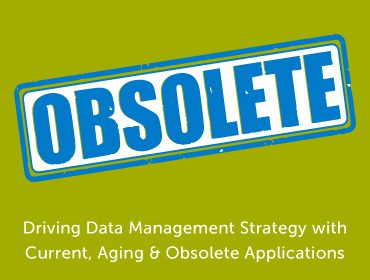
With the growth of healthcare data outperforming other big industries like manufacturing, financial services and media/entertainment; an information lifecycle management strategy is key. In thinking about a health data strategy, there are three categories in which to group electronic health record (EHR) systems and other software applications in healthcare: current, aging and obsolete.
- These EHRs and software applications are actively maintained and driving forward with patches, updates, and maintenance contracts in place.
- These EHRs and software applications aren’t the latest version with the newest features yet are still actively supported with patches and updates applied as necessary to troubleshoot issues.
- These EHRs and software applications are no longer sold, supported, patched or updated with increased vulnerability and security risk.
Software used in healthcare delivery organizations quickly moves from one of these categories to the next. That’s why developing or updating your organization’s legacy data management plan – including which systems to decommission by when — is one of the most important strategic long-haul efforts you can make. Following a systematic decommissioning program for outdated technology in healthcare reduces risk, ensures compliance, increases security, simplifies reporting, and decreases cost.
What are some current technology obstacles and gaps in healthcare?
- Hardware or operating software systems reach a point where they can’t be upgraded
- There’s no one left in the organization who understands how a certain program or system works
- There are workflow issues that are causing negative impacts in the organization
- Systems are kept running in read-only mode, driving up cost
- There is a lack of integration amongst systems in the organization
While the aging of EHRs and other software applications is inevitable, keeping obsolete systems and applications up and running isn’t necessary.
If you reach a point where your outdated healthcare technologies – the hardware or the operating system – can’t be upgraded, and there isn’t anyone in the organization who understands how it works, it’s time to move forward with migrating the data to a newer system or an active archive, like HealthData Archiver®.
The biggest misstep is to do nothing, which carries far greater risk system vulnerabilities, failures, and security breaches.
Four steps to focus on to create and/or update your legacy data management plan
- Work with business users – Make sure you have all the information needed to understand the needs and wants of the user community, such as Single Sign-On access from the go-forward system
- Keep an up-to-date inventory of all systems in play – Document the portfolio of systems and applications. If you need a tool, here’s a complimentary inventory template.
- Focus on compliance – Get a handle on Cures Act requirements and other specialty and state data retention guidelines.
- Create a systematic approach – Develop a process that can be repeated across the organization to decommission legacy operating systems and applications.
The end goal is to ensure the clinical, financial, and business data in your organization is accessible, usable, secure and compliant.
The decade ahead and the promise of interoperability.
Experts predict that the coming decade will continue to see unprecedented transformation in healthcare technology. Significant growth is expected in solutions that increase accessibility, integration, IoT devices and interoperability between EHRs. The less systems there are up and running in an organization, the fewer locations there are to address interoperability.
All things considered, health data may spend more time in an archive than it spends in an active EHR.
Many organizations have 30-40 or more legacy systems that need a safe, secure, and compliant long-term home for the data within their care. There are a lot of outdated healthcare technologies– all of which contain critical data — that are ripe for a better long-term data storage and access plan. Plus, often the data housed in the aging and obsolete systems must be retained for years or decades beyond what the EHR is able to support.
Where there once were thousands of EHRs, now there are roughly 500, with the lion’s share of the market controlled by three big players in terms of revenue: Epic, Cerner and Allscripts.
The Harmony Healthcare IT team works with healthcare delivery organizations of all sizes to make sure data is available, reportable, researchable and interoperable from within an archive versus stored in disparate, aging systems reaching obsolescence. With an active archive solution you should expect to:
- Lower costs
- Reduce risk
- Fortify cybersecurity defenses by decommissioning out-of-production applications
- Make legacy data more accessible to users and patients
Harmony Healthcare IT’s full-service legacy data management solutions: HealthData Archiver®, HealthData AR Manager®, and HealthData Locker™ are ready to help your team meet its best practices goals for complete lifecycle data management. We’re proud that Black Book™ Rankings, a division of Black Book™ Market Research, ranked Harmony Healthcare IT as the top Data Archiving, Data Extraction and Migration company.
Don’t let your aging and obsolete applications get you down.
We can help.






